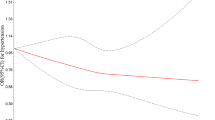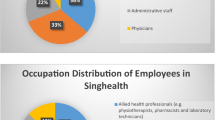Abstract
Objectives
The aim of this study is to examine the association between perceived stress and multifarious eating away from home among Chinese adults in different genders.
Methods
We examined cross-sectional data from the China Health and Nutrition Survey conducted in 2018 among Chinese adults aged 18–59 years. A self-reported questionnaire involving the perceived stress scale with 10 items (PSS-10), and the food frequency questionnaire about eating away from home were used. Adjusted two-level zero-inflated Poisson regression models were used to explore the association.
Results
There were 3161 males and 3599 females in the study. The median PSS-10 score was 16.0 and the frequencies of eating 1) breakfast, 2) lunch or supper, and 3) three main meals away from home were 12, 10, and 49 times per year, respectively. In males, PSS-10 score was not associated with eating away from home. In females, PSS-10 score was significantly positively associated with eating 1) lunch or supper, 2) three main meals, 3) Chinese food away from home, and 4) eating at stalls/restaurants (β1 = 0.016, P1 = 0.006; β2 = 0.014, P2 = 0.002; β3 = 0.015, P3 = 0.013; β4 = 0.014, P4 = 0.015 respectively). But there was not association between PSS-10 score and the frequency of eating breakfast away from home in females (β = 0.006, P = 0.325).
Conclusions
Stressed females tend to eat away from home, but the effects are very small.
This is a preview of subscription content, access via your institution
Access options
Subscribe to this journal
Receive 12 print issues and online access
$259.00 per year
only $21.58 per issue
Buy this article
- Purchase on Springer Link
- Instant access to full article PDF
Prices may be subject to local taxes which are calculated during checkout
Similar content being viewed by others
Data availability
The CHNS datasets used and/or analyzed during the current study are available at http://www.cpc.unc.edu/projects/china/data.
References
Tian X, Zhong L, von Cramon-Taubadel S, Tu H, Wang H. Restaurants in the neighborhood, eating away from home and BMI in China. PLoS One. 2016;11:e167721.
Ma H, Huang J, Fuller F, Rozelle S. Getting rich and eating out: consumption of food away from home in urban China. Can J Agric Econ/Rev Canadienne Dagroeconomie. 2006;54:101–19.
Cao K, He Y, Yang X. The association between eating out of home and overweight/obesity among Chinese adults. Chin J Prevent Med. 2014;12:1088–92.
Ma G, Kong L. Survey report on the nutrition and health status of Chinese residents (9): behavior and lifestyle in 2002. Beijing: People’s Medical Publishing House; 2006.
Yao Y, Gong GW, Song C, Zhang Y, Ma Y, Yuan F, et al. Out-of-home eating behavior analysis of Chinese adult residents, 2010-2012. Acta Nutrimenta Sin. 2019;41:10–14.
Orfanos P, Naska A, Trichopoulou A, Grioni S, Boer JM, van Bakel MM, et al. Eating out of home: energy, macro- and micronutrient intakes in 10 European countries. The European Prospective Investigation into Cancer and Nutrition. Eur J Clin Nutr. 2009;63:S239–S262. Suppl 4.
Naska A, Orfanos P, Trichopoulou A, May AM, Overvad K, Jakobsen MU, et al. Eating out, weight and weight gain. A cross-sectional and prospective analysis in the context of the EPIC-PANACEA study. Int J Obes. 2011;35:416–26.
Vandevijvere S, Lachat C, Kolsteren P, Van Oyen H. Eating out of home in Belgium: current situation and policy implications. Br J Nutr. 2009;102:921–8.
Zeng Q, Zeng Y. Eating out and getting fat? A comparative study between urban and rural China. Appetite 2018;120:409–15.
Kral TV, Roe LS, Rolls BJ. Combined effects of energy density and portion size on energy intake in women. Am J Clin Nutr. 2004;79:962–8.
Bezerra IN, Curioni C, Sichieri R. Association between eating out of home and body weight. Nutr Rev. 2012;70:65–79.
Burns C, Jackson M, Gibbons C, Stoney RM. Foods prepared outside the home: association with selected nutrients and body mass index in adult Australians. Public Health Nutr. 2002;5:441–8.
Lachat C, Nago E, Verstraeten R, Roberfroid D, Van Camp J, Kolsteren P. Eating out of home and its association with dietary intake: a systematic review of the evidence. Obes Rev. 2012;13:329–46.
Jia X, Liu J, Chen B, Jin D, Fu Z, Liu H, et al. Differences in nutrient and energy contents of commonly consumed dishes prepared in restaurants v. at home in Hunan Province, China. Public Health Nutr. 2018;21:1307–18.
Du W, Su C, Wang H, Wang Z, Zhang J, Zhang J, et al. Situation on ‘eating out’ and its related risk factors among 1013 Chinese adults in 3 provinces. Chin J Epidemiol. 2013;34:1159–63.
Dong X, Hu B. Regional difference in food consumption away from home of urban residents: a panel data analysis. Agriculture Agric Sci Procedia. 2010;1:271–7.
Bugge AB, Lavik R. Eating out: a multifaceted activity in contemporary Norway. Food Cult Soc. 2010;13:215–40.
El AW, Adetunji H, Oskrochi R. Food and mental health: relationship between food and perceived stress and depressive symptoms among university students in the United Kingdom. Cent Eur J Public Health. 2014;22:90–7.
Mikolajczyk RT, El AW, Maxwell AE. Food consumption frequency and perceived stress and depressive symptoms among students in three European countries. Nutr J. 2009;8:31.
Errisuriz VL, Pasch KE, Perry CL. Perceived stress and dietary choices: the moderating role of stress management. Eat Behav. 2016;22:211–6.
Barrington WE, Ceballos RM, Bishop SK, Mcgregor BA, Beresford SAA. Perceived stress, behavior, and body mass index among adults participating in a worksite obesity prevention program, Seattle, 2005-2007. Prevent Chronic Dis. 2012;9:E152.
Barrington WE, Beresford SAA, Mcgregor BA, White E. Perceived stress and eating behaviors by sex, obesity status, and stress vulnerability: findings from the vitamins and lifestyle (VITAL) study. J Acad Nutr Dietetics. 2014;114:1791–9.
Mouchacca J, Abbott GR, Ball K. Associations between psychological stress, eating, physical activity, sedentary behaviours and body weight among women: a longitudinal study. BMC Public Health. 2013;13:828.
Torres SJ, Nowson CA. Relationship between stress, eating behavior, and obesity. Nutrition. 2007;23:887–94.
Ng DM, Jeffery RW. Relationships between perceived stress and health behaviors in a sample of working adults. Health Psychol. 2003;22:638–42.
Popkin BM, Du S, Zhai F, Zhang B. Cohort profile: The China Health and Nutrition Survey—monitoring and understanding socio-economic and health change in China, 1989–2011. Int J Epidemiol. 2010;39:1435–40.
Zhang B, Zhai FY, Du SF, Popkin BM. The China Health and Nutrition Survey, 1989–2011. Obes Rev. 2014;15:2–7. Suppl 1.
Cohen S, Kamarck T, Mermelstein R. A global measure of perceived stress. J Health Soc Behav. 1983;24:385–96.
Huang F, Wang H, Wang Z, Zhang J, Du W, Su C, et al. Psychometric properties of the perceived stress scale in a community sample of Chinese. BMC Psychiatry. 2020;20:130–7.
Jones-Smith JC, Popkin BM. Understanding community context and adult health changes in China: development of an urbanicity scale. Soc Sci Med. 2010;71:1436–46.
Cheung GW, Rensvold RB. Evaluating goodness-of-fit indexes for testing measurement invariance. Struct Equ Modeling A Multidiplinary J 2002;9:233–55.
Meade AW, Johnson EC, Braddy PW. Power and sensitivity of alternative fit indices in tests of measurement invariance. J Appl Psychol. 2008;93:568–92.
Gong W, Chen Z, Zhang Y, Yuan F, Yao Y, Liu A. Status and influencing factors of breakfast consumption among Chinese adults. Acta Nutrimenta Sin. 2017;39:549–55.
Seguin RA, Anju A, Francoise V, Adam D. Consumption frequency of foods away from home linked with higher body mass index and lower fruit and vegetable intake among adults: a cross-sectional study. J Environ Public Health. 2016;2016:3074241.
Horst KVD, Brunner TA, Siegrist M. Fast food and take‐away food consumption are associated with different lifestyle characteristics. J Hum Nutr Dietetics. 2011;24:596–602.
Costa G, Pickup L, Di Martino V. Commuting—a further stress factor for working people: evidence from the European Community. II. An empirical study. Int Arch Occup Environ Health. 1988;60:377–85.
Erschens R, Herrmann-Werner A, Keifenheim KE, Loda T, Bugaj TJ, Nikendei C, et al. Differential determination of perceived stress in medical students and high-school graduates due to private and training-related stressors. PLoS One. 2018;13:e191831.
Wardle J, Steptoe A, Oliver G, Lipsey Z. Stress, dietary restraint and food intake. J Psychosom Res. 2000;48:195–202.
Lee YH, Shelley M, Liu CT, Chang YC. Assessing the association of food preferences and self-reported psychological well-being among middle-aged and older adults in contemporary China—results from the China Health and Nutrition Survey. Int J Environ Res Public Health. 2018;15:463.
Zhang J, Zhang B, Wang H, Wang Z, Du W, Su C, et al. Dietary patterns of Chinese adults in nine provinces. Chin J Epidemiol. 2013;34:37–40.
Yau YH, Potenza MN. Stress and eating behaviors. Minerva Endocrinol. 2013;38:255–67.
Eiji T, Junji T, Yutaka N, Ken-Ichi M, Yoshinobu B, Hiroshi C, et al. Stress control and human nutrition. J Med Investig. 2004;51:139–45.
Adam TC, Epel ES. Stress, eating and the reward system. Physiol Behav. 2007;91:449–58.
Russell E, Koren G, Rieder M, Van Uum S. Hair cortisol as a biological marker of chronic stress: current status, future directions and unanswered questions. Psychoneuroendocrinology 2012;37:589–601.
Acknowledgements
The author would like to thank all those who have worked on this research and all of the participants. This research was funded by the Carolina Population Center, University of North Carolina at Chapel Hill, grant number 5R24 HD050924; the National Institutes of Health, grant number R01-HD30880, DK056350, R24 HD050924, and R01-HD38700; and the Fogarty International Center, National Institutes of Health, grant numbers 5D43TW007709 and 5D43TW009077.
Author information
Authors and Affiliations
Contributions
FH, HW, and BZ were responsible for the study concept and design. FH wrote the manuscript. HW and BZ revised the manuscript. FH, WD, YOY were responsible for the investigation. BZ required the fund. All of the authors approved the draft of the manuscript.
Corresponding author
Ethics declarations
Competing interests
The authors declare no competing interests.
Additional information
Publisher’s note Springer Nature remains neutral with regard to jurisdictional claims in published maps and institutional affiliations.
Rights and permissions
About this article
Cite this article
Huang, F., Wang, H., Wang, Z. et al. Stressed females, rather than males, tend to eat away from home. Eur J Clin Nutr 76, 1010–1016 (2022). https://doi.org/10.1038/s41430-021-01058-2
Received:
Revised:
Accepted:
Published:
Issue Date:
DOI: https://doi.org/10.1038/s41430-021-01058-2



